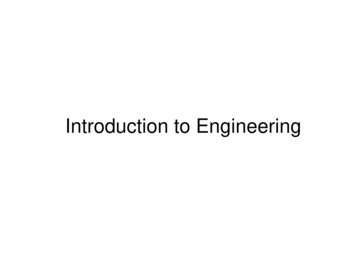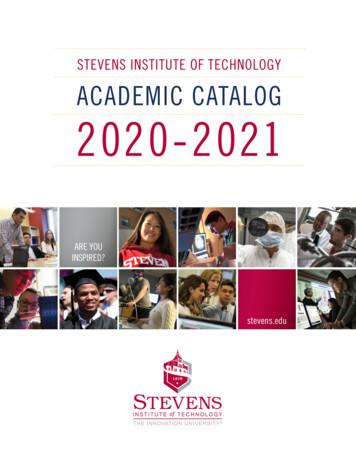Engineering Design I: Methods And Skills Topic Readings
Engineering Design I: Methods and SkillsTopic ReadingsJun Hong Park and Steven H. CollinsDecember 5, 2015
Chapter 11Engineering DrawingsAn engineering drawing is a representation of an engineered product used toclearly define all features and requirements. Good engineering drawings mustbe clear, organized and thorough. In this reading, we will learn where engineeringdrawings are used, what their basic elements are, and how to generate a drawingwith geometric dimensioning and tolerancing.11.1How are Engineering drawings used?Documenting a Product’s Life: Engineered products are often designed and revised by multiple people over long periods of time. A CAD model can be veryuseful for visually understanding the product, but it is not very good at documenting changes and highlighting important features. With engineering drawings, youcan denote important features and document revisions and changes made in therevision.Manufacturing: Engineering drawings are still the primary tool machinists andtechnicians use to understand the geometry of a product and its important designfeatures. Depending on how you dimension and tolerance your drawing, the manufacturing method can vary significantly, effecting the final cost of production.Quality Inspection: No part will ever be a perfect match to the CAD model. Partswill have variation in geometries and dimensions based on material and manufacturing methods. Proper engineering drawings give inspectors ranges of acceptabledimensions and geometries and any other important information.2
11.2. ELEMENTS OF A DRAWING3Figure 11.1: Primary elements of an engineering drawing. See Section 11.2.1 foran explanation of each.11.2Elements of a DrawingMost engineering companies will have a unique template, but there are some engineering standards set by the International Organization for Standardization (ISO).These standards are adopted by most if not all engineering firms, and cover mostimportant aspects of engineering drawings. Some symbols, footnotes and aspectsof the layout style can vary, but in this reading we will go over the most widelyused conventions and common elements.11.2.1Basic Layouts & NotesThe primary elements of an engineering drawing (Figure 11.1) are:1. Grid System: Drawings are designed to communicate an idea, and a convenient way to locate specific parts of the drawing is to have a grid. Forexample, in this drawing, the dimension of 1.18” will be in grid B-42. Title Block: Title block holds general information like the part number, description, author and approvers. It also contains general information that
4CHAPTER 11. ENGINEERING DRAWINGScan be important when reading and interpreting the document, such as general tolerances, units, and scales. Often legal disclaimers are included here.3. Revision Block: The revision block contains number of this revision and abrief description of changes made for said revision. Some revision blocksalso include the location of the change in the drawing by specifying pagenumber and grid location. It is important to note every revision.4. Bill of Materials: The bill of materials (BOM) contains all parts includedin an assembly. In a part drawing, the BOM will not be present. As seen onthe example above, there are bubbles (section A2) with numbers in them.These numbers correspond to BOM lines. The BOM should at least havepart numbers, descriptions and quantities used in the assembly. For complexassemblies, you can find BOM’s with multiple sub-assemblies.5. Notes: Notes are added to drawings to provide additional information thatcannot be represented with pictures. In this case, the drawing has a flagnote, which refers to a specific location of the drawing. A general note (notewithout symbols) applies to the entire drawing. Notes can specify material,instructions for technicians and inspectors, finish, or assembly methods.11.2.2Drawing ViewsDrawings are two-dimensional, and therefore need multiple views in order to display all features of a three-dimensional model. We will go over some commonlyused views. Note that a drawing will have as many views as necessary to showthe entire geometry.Front, Top and Side ViewsFront, Top and Side views are orthographic projections of an object onto threeplanes, typically the three principal planes (the x-y plane, y-z plane and the x-zplane). The top view should appear above front view and the right view shouldappear to the right of the front view (Figure 11.2). When laying the views out onthe drawing, make sure the views line up with each other.Isometric ViewAn isometric view is a projection of the three-dimensional object onto a plane thatis at equal angles to the principal coordinate system of the part. Isometric viewsare helpful for showing the general shape of the object, and provide a good visualreference. Isometric views should not be used for dimensioning, because it can bedifficult to identify which features are being referenced.
11.2. ELEMENTS OF A DRAWING5Figure 11.2: The most common views in an engineering drawing are front, topand side orthographic views and an isometric view.Cross-Sectional ViewCross-Sectional Views are used to display internal features that are difficult to seein other views. They are also a useful way to identify and dimension internalfeatures. Cross-sectional views have a cut line on another view, and will have aprojection of the object if it were to be cut along the plane perpendicular to thereferenced view, and intersecting the cut line (Figure 11.3.A).Auxiliary ViewAuxiliary views are used to show the true shape of a feature that is not parallelto any principal plane. Auxiliary views are parallel to the primary plane of thefeature of interest, and sometimes do not show the entire object (Figure 11.3.B).Exploded ViewExploded views show the individual parts of an assembly slightly separated fromeach other, usually following a consistent pattern. In the example provided, allcomponents are moved only along the primary axis of rotation of the assembly(Figure 11.3.C). Exploded views can be helpful in understanding how things fittogether.
6CHAPTER 11. ENGINEERING DRAWINGSA. Cross-Sectional ViewB. Auxiliary ViewsC. Exploded ViewFigure 11.3: Examples of specialty views.
11.2. ELEMENTS OF A DRAWING7Figure 11.4: Line types used in engineering drawings and their meaning.11.2.3Lines Used in Engineering DrawingsLine weight, dash and other properties are used to indicate the meaning of a line inengineering drawings. The most common line type is ‘continuous thick’, used todepict visible part edges (corners or places where a curve becomes tangent to theline of view). Another common line type is ‘dashed thick’, used to depict hiddenedges (part edges behind material from the current view). Dimensioning lines aretypically ‘continuous thin’. Additional line types are explained in Figure 11.4.
811.3CHAPTER 11. ENGINEERING DRAWINGSGD&T BasicsGeometric Dimensioning and Tolerancing (GD&T) refers to a set of symbolscommonly used in engineering drawings to define allowable deviations in geometry. The language of GD&T consists of dimensions, tolerances, symbols,definitions, and conventions that can be used to precisely communicate functionalrequirements for the location, orientation, size, and form of each feature of a design. These symbols communicate design design intent and requirements to manufacturers and quality inspectors. The current standard is ASME Y14.5-2009.11.3.1DimensionsBy dimensioning a feature, the author of the drawing is implying the importanceof the accuracy and the acceptable tolerance. In the title block, default tolerancesare often specified based on number of decimal points, e.g.: “Unless specified otherwise, x.xxx 0.005, x.xx 0.01, x.x 0.1”. If a different tolerance is required, x.xxx should be added to the dimension. All specified dimensions imply importance, and will be assessed during quality inspection. When designing a part,think carefully about which dimensions are most important and how much erroris acceptable. If required tolerances are tight, try to make design changes thatimprove robustness against manufacturing errors and therefore increase the acceptable error and reduce part cost. After working through this process iteratively,be sure to note the acceptable tolerances in the engineering drawing of the part.Reference dimensions are used to specify overall dimension (good for pickingstarting material) or dimensions driven by other features (useful for helping thereader to understand the intent of the non-reference dimensions). Reference dimensions are identified by putting parentheses around the dimension value, suchas: “(3.450)”. Reference dimensions are considered secondary, and will not bechecked by quality inspectors.11.3.2DatumsDatum symbols define the locations which will be used as a reference for otherdrawing dimensions and constraints. All GD&T symbols except for the set defining form (Straightness, Flatness, Circularity, Cylindricity) can or must use datums.A datum can be plane, axis or point that is theoretically exact. Because datumsare theoretically exact it is good to use datums on surfaces, axes or points that canbe realistically measured. Keep in mind that no real surface or edge can be exact.Datums are listed in alphabetical order by importance, so when manufacturing apart datum A will be set first, then datum B and so on.
11.3. GD&T BASICS9Figure 11.5: Examples of datums. Top: The datum symbol. Middle: Two ways ofdefining a datum surface. Bottom: Cylindrical axis datums are defined by placingthe datum symbol on the leader of the diameter dimension.11.3.3SymbolsGD&T symbols are used when dimensions alone cannot describe the requiredgeometry or to simplify the drawing. Generally, the GD&T symbols are showndirectly on the related dimension or pointing to the feature being referenced. Convention is to display a box with the symbol inside, then a box with the tolerance,and then datums it references, if applicable. Because there are many possiblesymbols, we will go over only the most commonly used ones. More informationcan be found at: http://www.gdandtbasics.com/ or in reference textssuch as “GeoTol Pocket Guide” by Neumann & Neumann.11.3.4Form SymbolsSymbols that control form indicate acceptable tolerances for the shape of a part.The indicated feature generally needs to be within two imaginary offset features.The two most commonly used symbols for form are flatness and cylindricity.Form does not reference any datum.
10CHAPTER 11. ENGINEERING DRAWINGSFlatnessBy adding the flatness symbol, the engineer is requiring a surface to be flat withinspecified tolerance. This means that the irregularity of the surface has to be withintwo parallel surfaces that are separated by the specified tolerance. The largestdifference (highest peak and lowest valley) must be within the tolerance or thepart will be rejected. Usually when setting a surface as a datum, the surface willalso have a flatness requirement.Figure 11.6: The flatness symbol and its use and meaning.CylindricityBy adding the cylindricity symbol, the engineer is requiring a surface to be cylindrical. This means that the irregularity of the surface has to be within two concentric cylinders that are separated by the specified tolerance. The largest differencemust be within the tolerance.Figure 11.7: The cylindricity symbol and its use and meaning.
11.3. GD&T BASICS11.3.511Profile SymbolsProfile requirements are used for splines and curved surfaces to which flat or cylindrical form requirements cannot be applied. Due to the difficulty of checkingcurved surfaces, datums can be useful in defining the ideal profile, but datums areoptional. There are two symbols in this category, line profile and surface profile,of which surface profile is more commonly used.Surface ProfileAs with form, the surface profile symbol indicates that a surface must be true tothe model within a tolerance. If no datum is present, the method of checking issimilar to form. Most of the time, a surface profile callout will reference datumsin order to create the ideal profile to check against.Figure 11.8: The surface profile symbol and its use and meaning.11.3.6Orientation SymbolsThe two most commonly used orientation symbols are perpendicularity and parallelism. Both require a surface datum. As with other symbols, orientation requirements use an ideal plane and two parallel tolerance planes.
12CHAPTER 11. ENGINEERING DRAWINGSPerpendicularityPerpendicularity is used very often, and just like other symbols, the tolerancezones are 2 parallel planes that are equidistance away from the ideal parallel plane.Perpendicularity can also be applied to an axis, and often used for hole alignments.For axis perpendicularity, a tolerance cylinder is drawn around the ideal axis thatis perpendicular to the datum surface.Figure 11.9: The perpendicularity symbol and its use and meaning.ParallelismParallelism is very intuitive, in a sense that that the tolerance surfaces will be parallel to the datum surface. Sometime, an inspector gets a large set of coordinatesof the datum surface and the called out surface, and individually check the parallelism, to get even more accurate data, but if the datum surface is out of tolerance,this method will not work.Figure 11.10: The parallelism symbol and its use and meaning.
11.3. GD&T BASICS11.3.713Location SymbolsLocation requirements are important, but can be complicated to implement because they require more datums and dimensions to be defined and incorporated.Position (True Position)True position is one of the most useful GD&T symbol but also the most complicated. Unlike other symbols, True Position uses relative distance from the “trueposition” to actual position. True position is commonly used for finding centersof holes, and typically requires two datums. Because the tolerance is set by theradius around the true position, the equation shown below must be used to see ifthe true position is met.Figure 11.11: The position symbol. The top diameter callout defines the diameterand diameter tolerance for the hole. The boxed elements on the dimension leaderare, from left to right, the position symbol, the hole axis position tolerance (thediameter of the circle defining the tolerable region), and the datums of the firstand second reference edges. Note that the dimensions defining hole location arealso boxed, as they are part of the position requirement.Figure 11.12: Evaluating the position tolerance.
14CHAPTER 11. ENGINEERING DRAWINGSConcentricityConcentricity is checked by making a tolerance cylinder around the ideal axis thatis set by the datum axis. The datum axis needs to be set by a cylindrical featurewith an axis. The tolerance appearing to the right of the concentricity symboldefines the diameter of the cylindrical tolerance zone in which the feature axiscan be located.Figure 11.13: The concentricity symbol and its use and meaning.11.3.8Runout SymbolsRunout refers to the variation in the radius of a cylindrical feature as it is rotatedabout a datum axis. This is similar to cylindricity, with the difference being thatthe datum axis is not the same as the feature axis. There are two types of runout,circular and total, of which total runout is the more common and more restrictive.
11.4. ACKNOWLEDGMENTS15Total RunoutTotal runout is useful when the entire rotating surface is critical to the part’s function. The tolerance zone is in the shape of a tube with the wall thickness of thetube specified to the right of the total runout symbol. Usually, inspection will beperformed by running an indicator on a surface while rotating the part within a vblock. For total runout, the indicator will be slowly moved axially, so as to samplea large portion of the outer surface of the feature.Figure 11.14: The total runout symbol and its use and meaning.11.4AcknowledgmentsThanks to Jun Park for help in drafting this chapter.
16CHAPTER 11. ENGINEERING DRAWINGSFigure 11.15: Table of common GD&T symbols with abbreviated meaning anduse. From ram.jpg)
11.3. GD&T BASICS 11 11.3.5 Profile Symbols Profile requirements are used for splines and curved surfaces to which flat or cylin-drical form requirements cannot be applied. Due to the difficulty of checking curved surfaces, datums can be useful in defining the ideal profile, but datums are optional.
Texts of Wow Rosh Hashana II 5780 - Congregation Shearith Israel, Atlanta Georgia Wow ׳ג ׳א:׳א תישארב (א) ׃ץרֶָֽאָּהָּ תאֵֵ֥וְּ םִימִַׁ֖שַָּה תאֵֵ֥ םיקִִ֑לֹאֱ ארָָּ֣ Îָּ תישִִׁ֖ארֵ Îְּ(ב) חַורְָּ֣ו ם
Materials Science and Engineering, Mechanical Engineering, Production Engineering, Chemical Engineering, Textile Engineering, Nuclear Engineering, Electrical Engineering, Civil Engineering, other related Engineering discipline Energy Resources Engineering (ERE) The students’ academic background should be: Mechanical Power Engineering, Energy .
Careers in Engineering Guide the brighter choice. Contents ABOUT LSBU 4–5 BUILDING SERVICES ENGINEERING 6–7 CHEMICAL AND PETROLEUM ENGINEERING 8–9 CIVIL ENGINEERING 10–11 ELECTRICAL AND ELECTRONIC ENGINEERING 12–13 MECHANICAL ENGINEERING 14–15 MECHATRONICS ENGINEERING 16–17 PRODUCT DESIGN ENGINEERING 18–19 An engineering degree is a big challenge to take on. There is no denying .
OLE MISS ENGINEERING RECOMMENDED COURSE SCHEDULES Biomedical engineering Chemical engineering Civil engineering Computer engineering Computer science Electrical engineering General engineering Geological engineering Geology Mechanical engineering Visit engineering.olemiss.edu/advising for full course information.
Mechanical Engineering Aerodynamic Design of Vehicles Compute Aided Analysis & Design Analysis & Design. Mechanical Engineering Wind Energy Fuel Cell Energy. Mechanical Engineering UAV Space Shuttle Air & Space. Mechanical Engineering Robotics Utilities Systems. Civil Engineering Foundation Structural Analysis Analysis & Design. Civil Engineering Bridge Skyscraper Tunnel Construction . Civil .
The College of Engineering offers six Bachelor of Science in engineering programs – bioengineering, chemical engineering, civil engineering, computer science and engineering, electrical engineering and mechanical engineering. A seventh program, the Bachelor of Sciencein environmental engineering
Civil Engineering 30 Computer Systems Engineering 32 Engineering Science 34 Electrical and Electronic Engineering 36 Mechanical Engineering 38 Mechatronics Engineering 40 Software Engineering 42 Structural Engineering 44 Course descriptions 46 APPENDIX 84 Find out more 88. 2 Dates to remember 06 Jan Summer School begins 12 Jan Last day to add, change or delete Summer School Courses 01 Feb .
ABET ,https://www.abet.org: biomedical engineering, chemical engineering, civil engineering, computer engineering, electrical engineering, environmental engineering, engineering management, mechanical engineering, and engineering. The computer science program is accredited by the Computing Accreditation Commission (CAC) of ABET,























